Home / Primary, Secondary, Tertiary, Quaternary In Organic Chemistry
Alkanes and Nomenclature
Primary, Secondary, Tertiary, Quaternary In Organic Chemistry
Last updated: February 6th, 2025 |
How To Recognize Primary, Secondary, Tertiary (and sometimes Quaternary) Hydrocarbons, Carbocations, Alkyl Halides, Alcohols, Amines, and Amides.
- Primary (1°), secondary (2°), tertiary (3°) and quaternary (4°) alkyl carbons are defined according to the number of carbons directly attached to that carbon.
- Similar nomenclature can be used for carbocations. Primary (1°), secondary (2°), and tertiary (3°) carbocations are defined according to the number of carbons directly attached to the carbon bearing the positive charge.
- Primary (1°), secondary (2°), and tertiary (3°) alcohols are defined according to the number of carbons directly attached to the carbon bearing the hydroxyl group.
- Primary (1°), secondary (2°), and tertiary (3°) alkyl halides are defined similarly to alcohols.
- Amines and amides are defined according to the number of carbons directly attached to the nitrogen atom.
- This classification system only applies to sp3 hybridized carbons (alkyl).
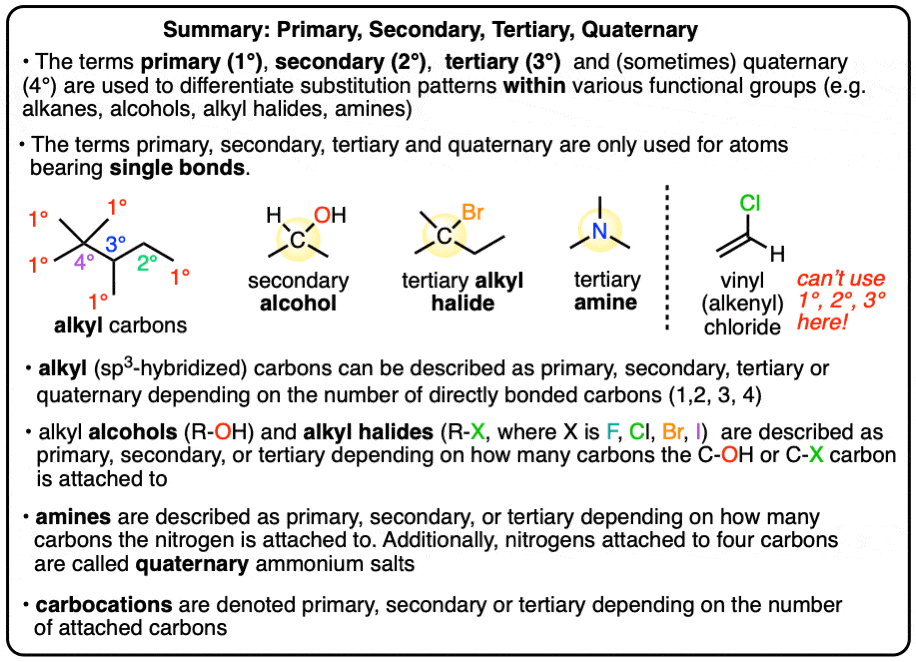
Table of Contents
- Primary, Secondary, Tertiary and Quaternary Alkyl Hydrocarbons
- Primary, Secondary, and Tertiary Carbocations
- Primary, Secondary and Tertiary Alcohols
- Primary, Secondary, and Tertiary Alkyl Halides
- The Special Case of Methane and Methyl
- Primary, Secondary, and Tertiary Amines (and Quaternary Ammonium Salts)
- Primary, Secondary and Tertiary Amides
- Notes
- Quiz Yourself!
- (Advanced) References and Further Reading
1. Primary, Secondary, Tertiary, and Quaternary Alkyl Hydrocarbons
There are four possible bonding patterns for alkyl carbons in hydrocarbons.
- Primary carbons (1°), are carbons attached to one other carbon and three hydrogens. Also known as a methyl (CH3)
- Secondary carbons (2°) are attached to two other carbons and two hydrogens. Also known as methylene (CH2) carbons.
- Tertiary carbons (3°) are attached to three other carbons and one hydrogen. Also known as methine (R3CH) carbons.
- Finally, quaternary carbons (4°) are attached to four other carbons.
You can’t go higher than that! To have five substituents, you’d need 10 electrons around carbon, a clear violation of the octet rule. When people do write 5 covalent bonds around carbon, it’s a mistake. [Note 1]
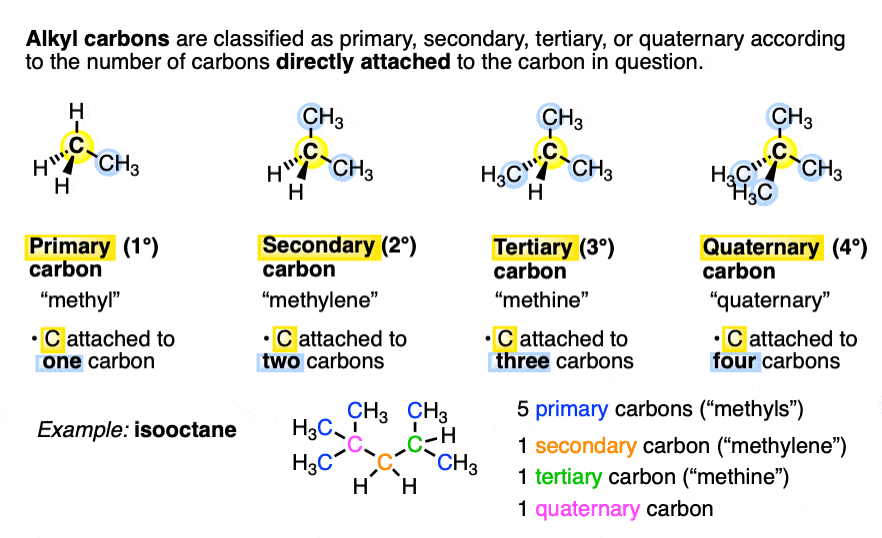
Ready to flex your muscles in a test? See if you can properly identify all the labelled carbons on testosterone.
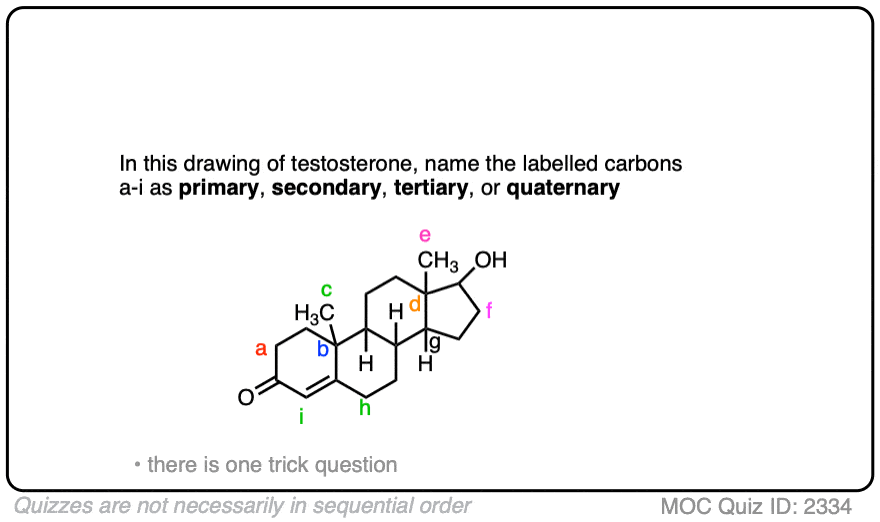 Click to Flip
Click to Flip
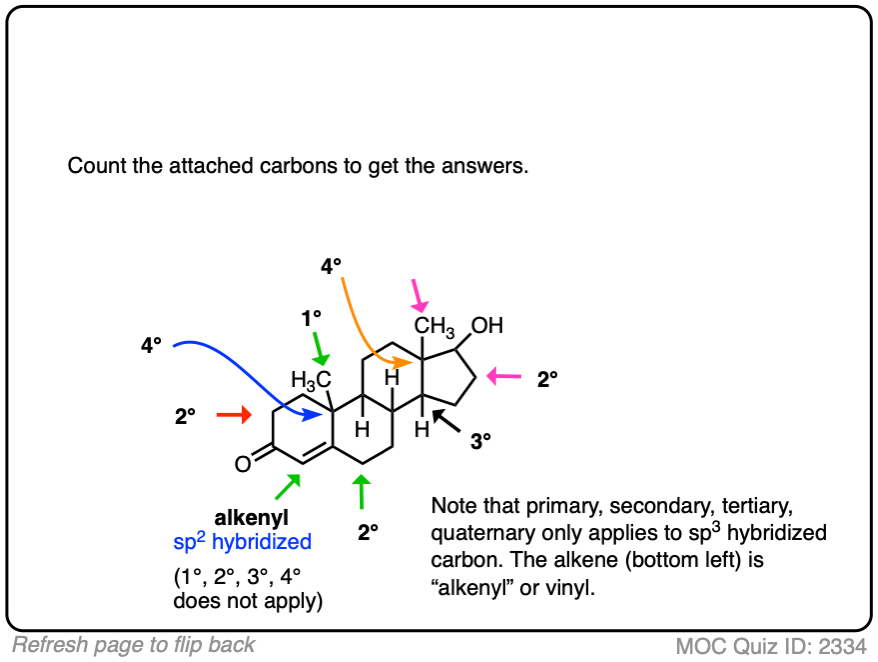
2. Primary, Secondary, and Tertiary Carbocations
Carbocations can also be classified as primary, secondary, or tertiary according to the number of carbons directly attached to the positively charged carbon.
Quaternary carbocations don’t exist. The problem is that the extra p-orbital on carbon would bring the number of orbitals on carbon to 5, violating the octet rule.
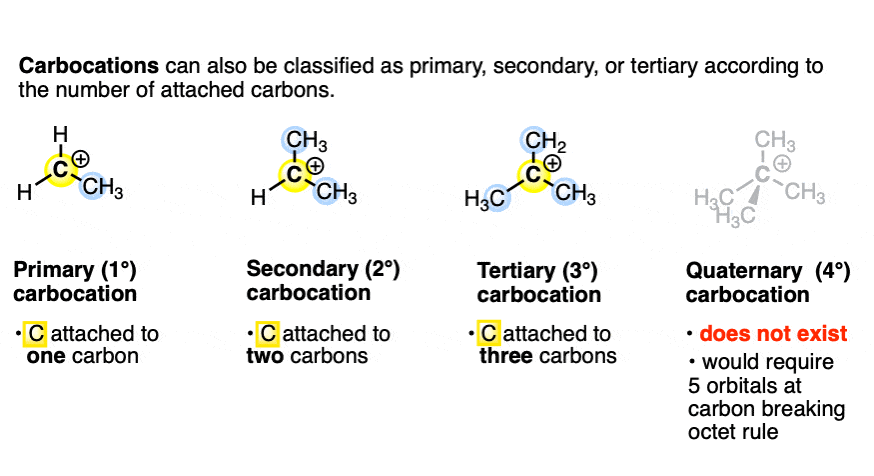
See if you can properly classify the following carbocations as primary, secondary, or tertiary.
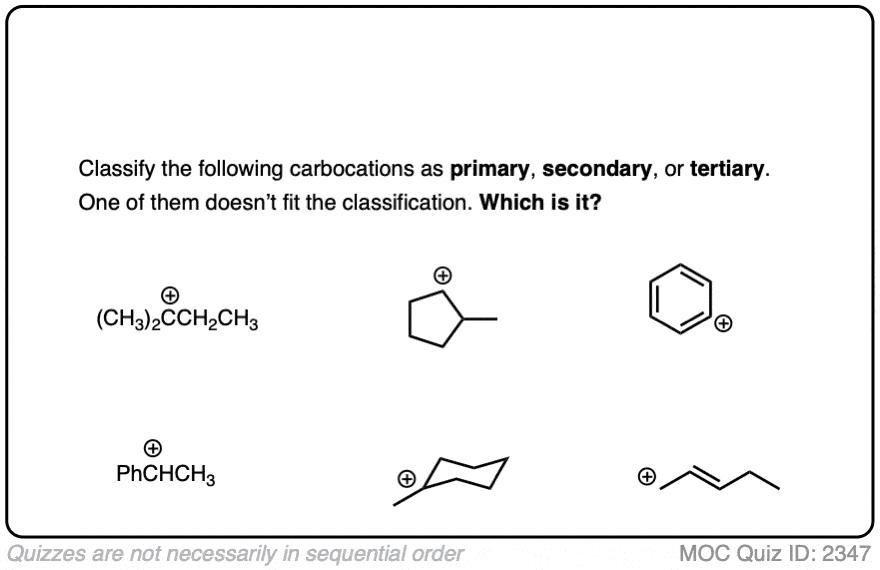 Click to Flip
Click to Flip
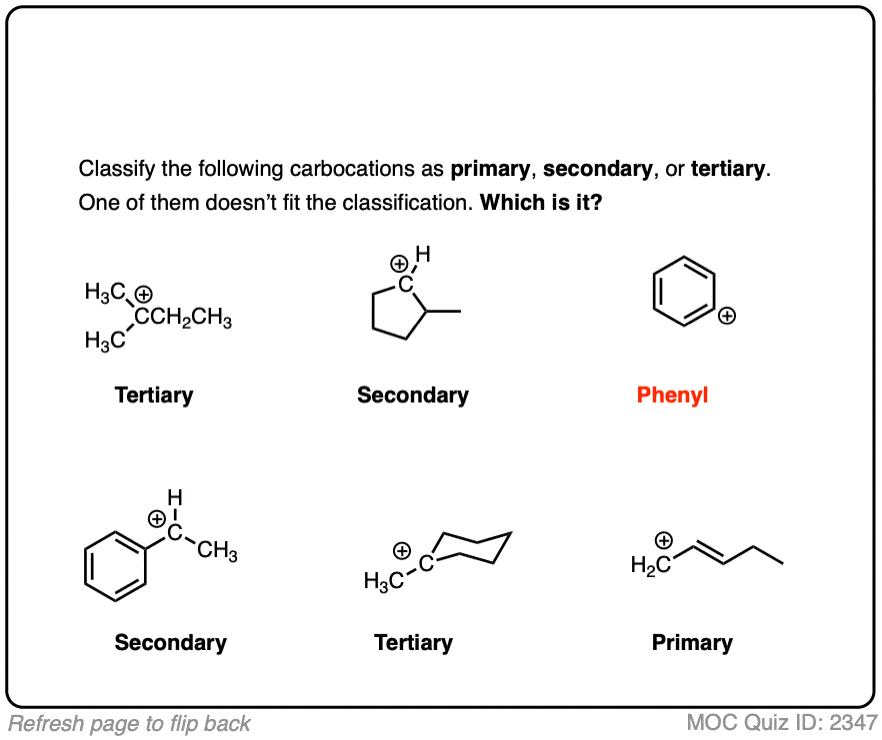
It’s important to note that the terms primary, secondary, tertiary and quaternary only apply for alkyl carbons and carbocations. When the carbon participates in pi-bonding, different names are applied.
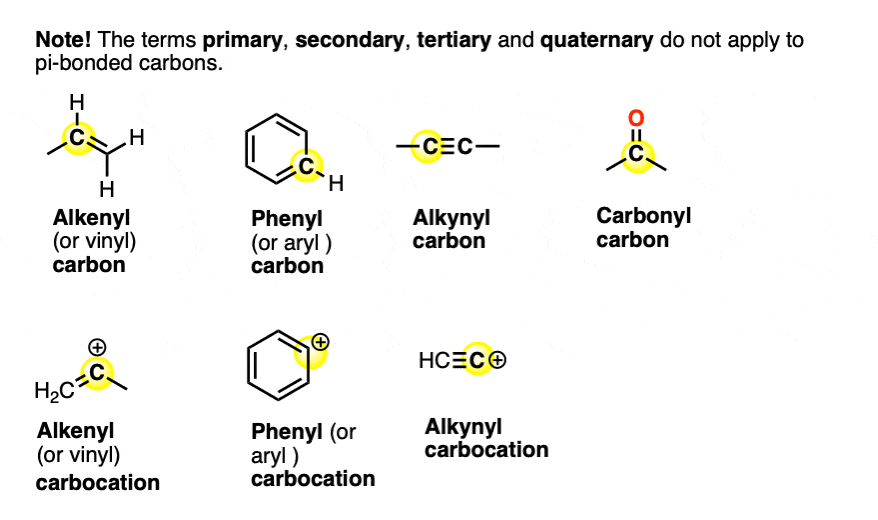
3. Primary, Secondary, and Tertiary Alcohols
Primary, secondary, and tertiary alcohols are named according to the number of carbons directly attached to the C-OH carbon. (This carbon is sometimes known as the carbinol carbon).
There is no such thing as a quaternary alcohol because that would require having 5 bonds to carbon.
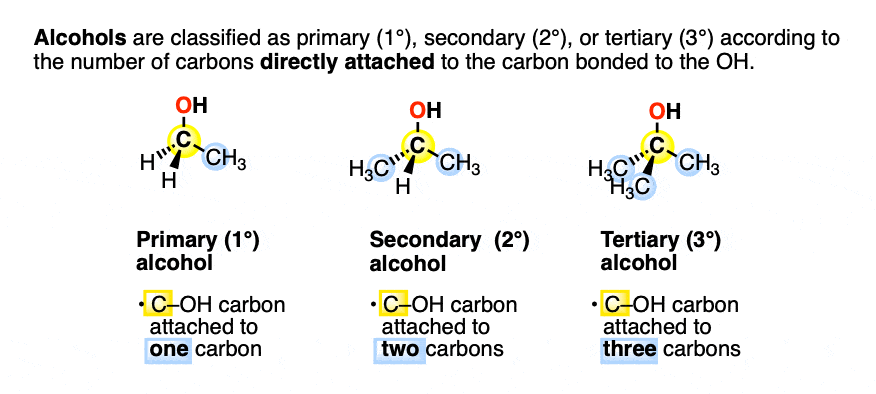
See if you can classify the following alcohols as primary, secondary, or tertiary.
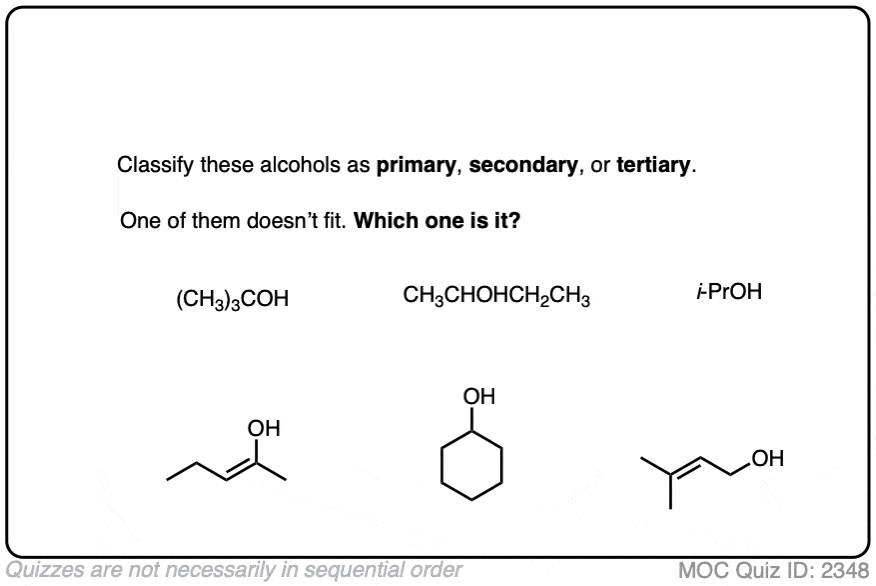 Click to Flip
Click to Flip
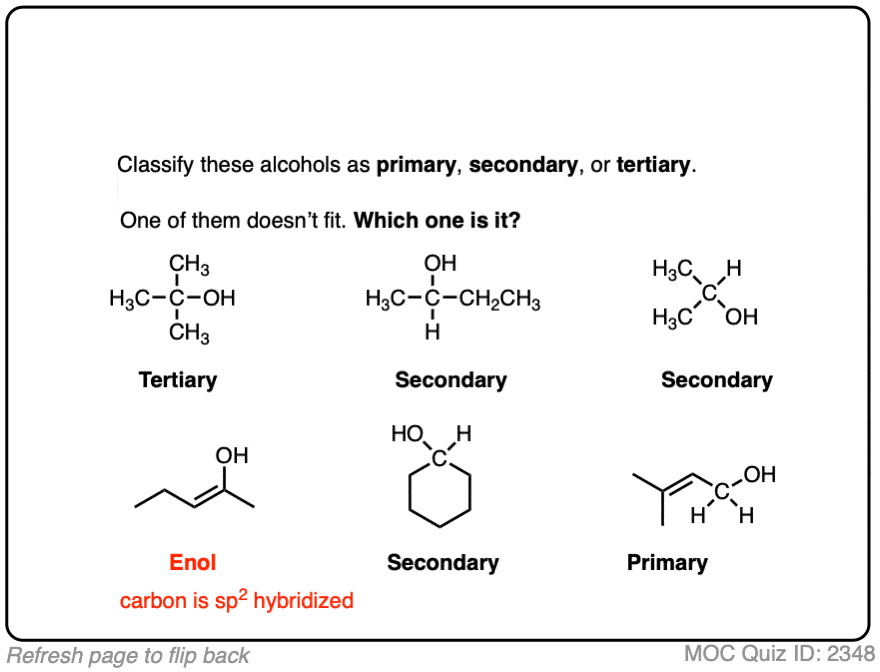
4. Primary, Secondary, and Tertiary Alkyl Halides
Alkyl halides have an sp3 hybridized carbon directly attached to a halogen.
Like alcohols, they are named according to the number of carbons directly attached to the carbon containing the halogen.
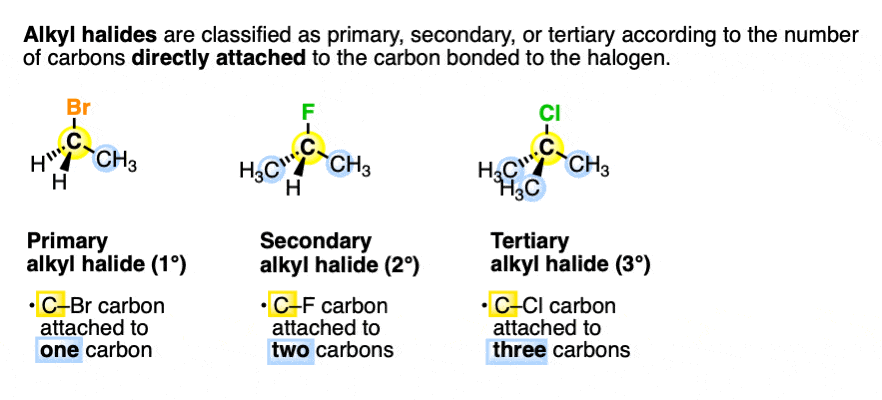
See if you can properly classify the following alkyl halides as primary, secondary, or tertiary.
 Click to Flip
Click to Flip
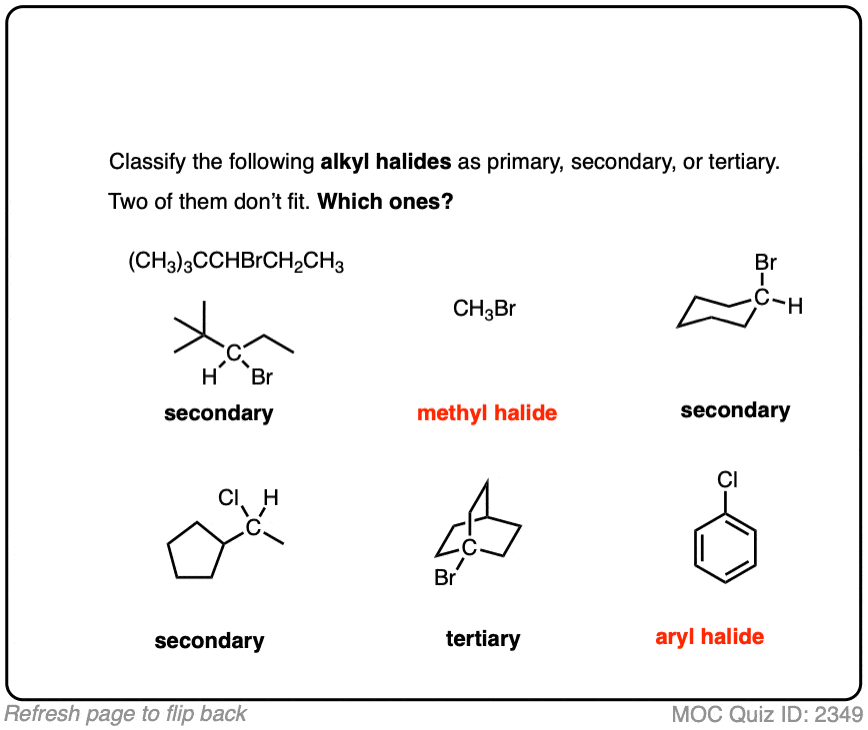
Just to give you fair warning, being able to classify alkyl halides as primary, secondary or tertiary is a key skill. When you encounter nucleophilic substitution and elimination reactions, you’ll see that the reactivity of alkyl halides is significantly affected by their substitution pattern.
5. A Special Case: Methane And Methyl Groups
Up to this point we’ve left out the special case of methane, the only hydrocarbon which lacks any carbon-carbon bonds.
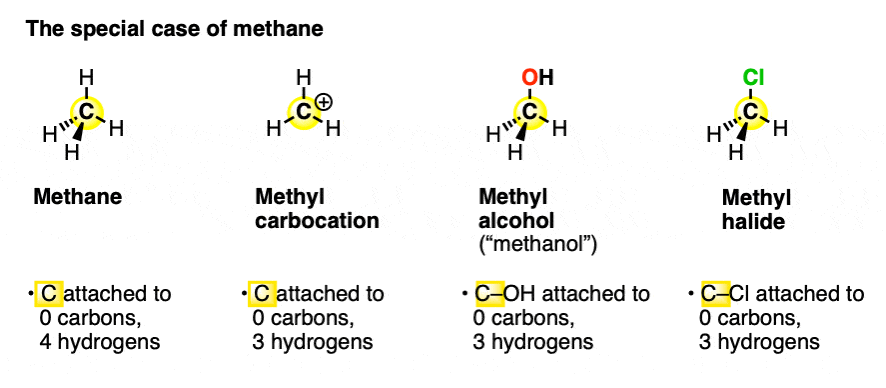
Methane, the methyl carbocation, methanol, and methyl halides are distinct from the “primary, secondary, tertiary” naming convention.
6. Primary, Secondary, and Tertiary Amines (and Quaternary Ammonium Salts)
Next, we come to amines, which are named a little bit differently than the previous examples. [Note 2]
Amines are named according to the number of carbons attached to the nitrogen.
Primary, secondary, and tertiary amines are nitrogens bound to one, two and three carbons, respectively.
It is possible for the nitrogen to be bound to a fourth carbon. This species is known as an alkylammonium salt. It is not technically an amine since it lacks a lone pair on nitrogen and cannot act as a base.
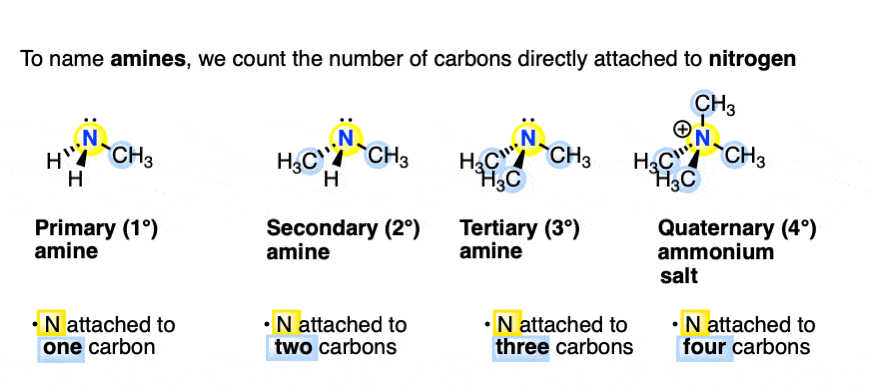
Remember that the positive formal charge on nitrogen doesn’t imply that there is an empty p orbital there! Always assume a full octet on positively charged nitrogen and oxygen.
See if you can tell the difference between these primary, secondary and tertiary amines.
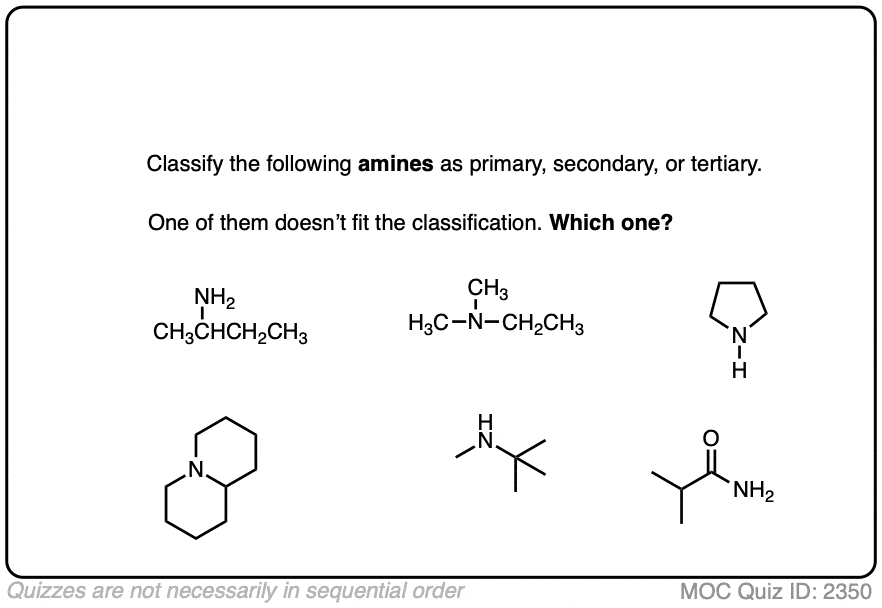 Click to Flip
Click to Flip
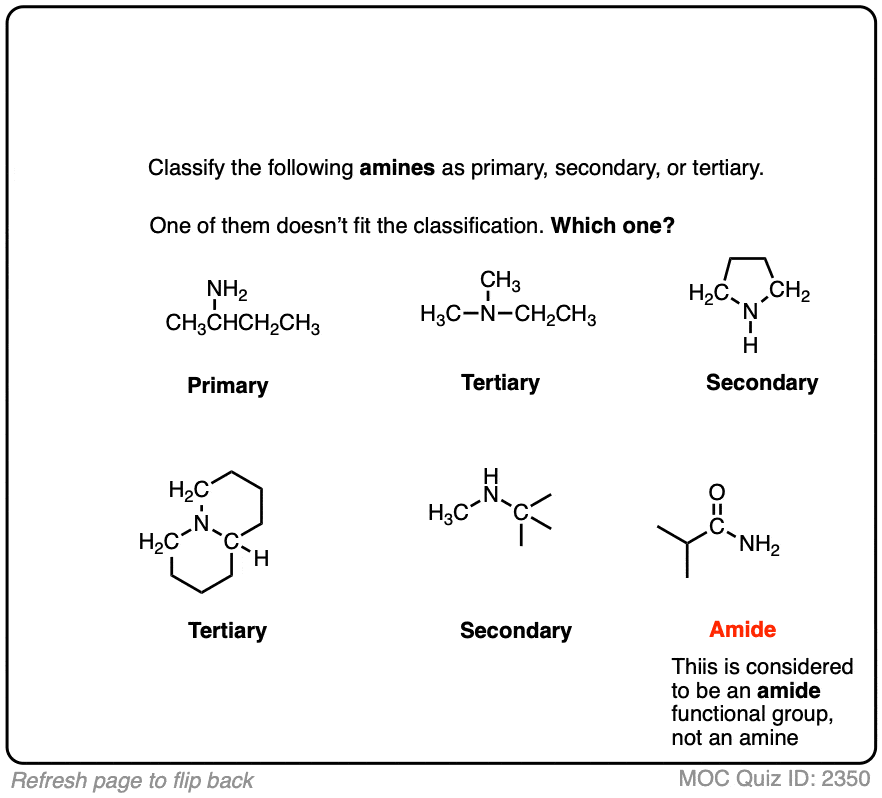
7. Primary, Secondary, and Tertiary Amides
The naming of amides is similar to that of amines.
A primary amide has the nitrogen bonded to one carbon – the carbonyl carbon.
Secondary and tertiary amides have the nitrogen bonded to two and three carbons respectively. (There is an amide counterpart to a quaternary ammonium salt, but it goes by a different name and you might go through introductory organic chemistry without ever seeing an example. – Note 3)
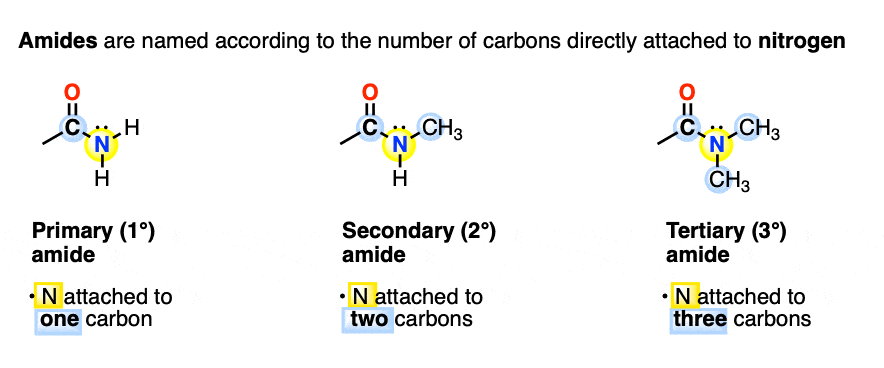
Quiz yourself on naming amides, here.
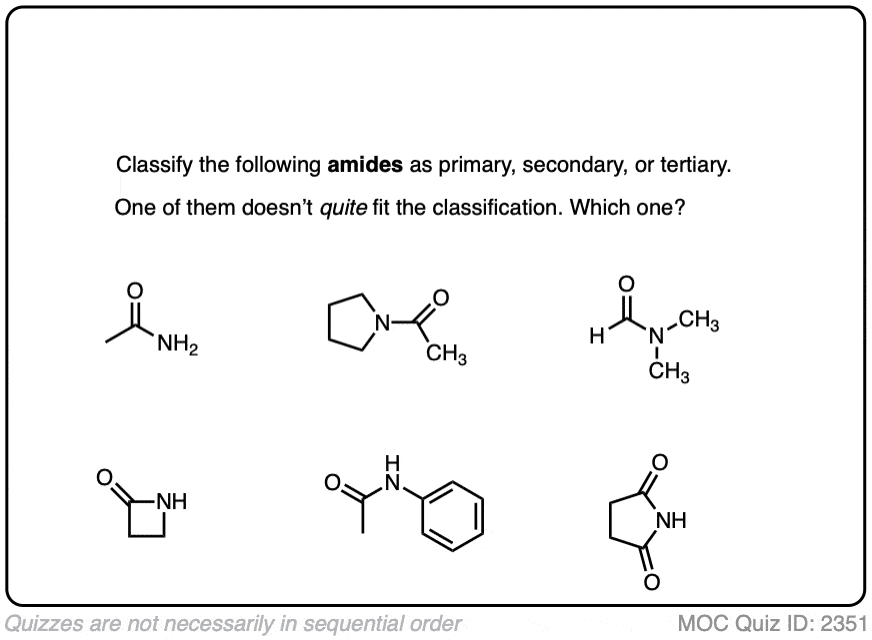 Click to Flip
Click to Flip
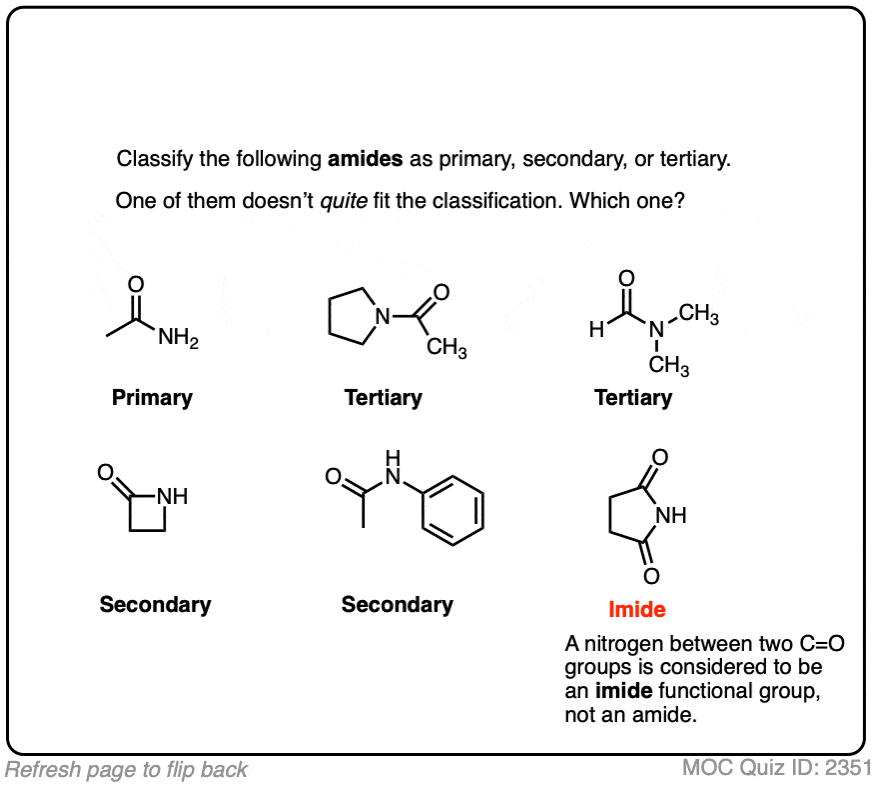
Notes
Related Articles
Note 1. These are often called Texas carbons because it resembles a star and because, y’know, “everything is bigger in Texas”.
Note 2. Note that methylamine is a primary amine, but methyl alcohol is not a primary alcohol.
Note 3. These are called acylammonium salts.

Quiz Yourself!
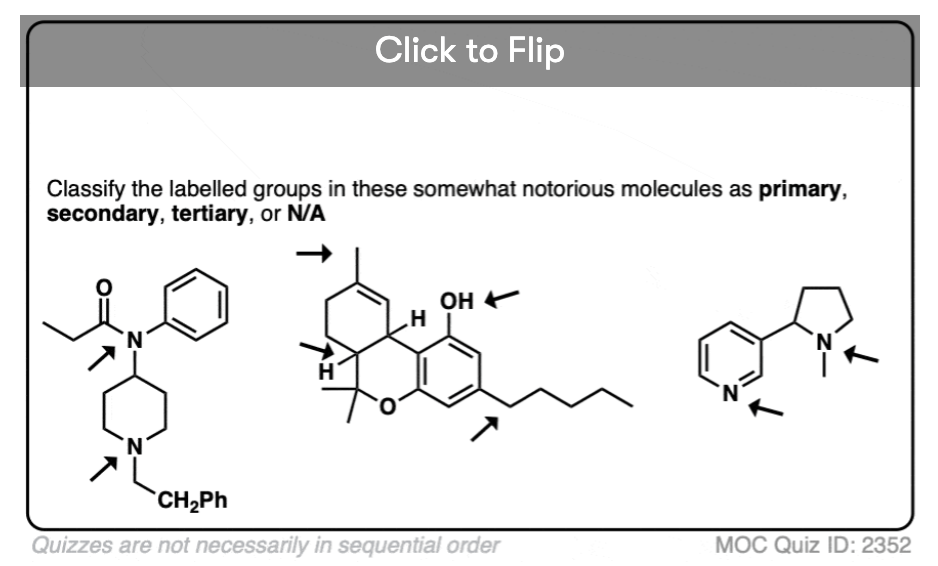
Become a MOC member to see the clickable quiz with answers on the back.
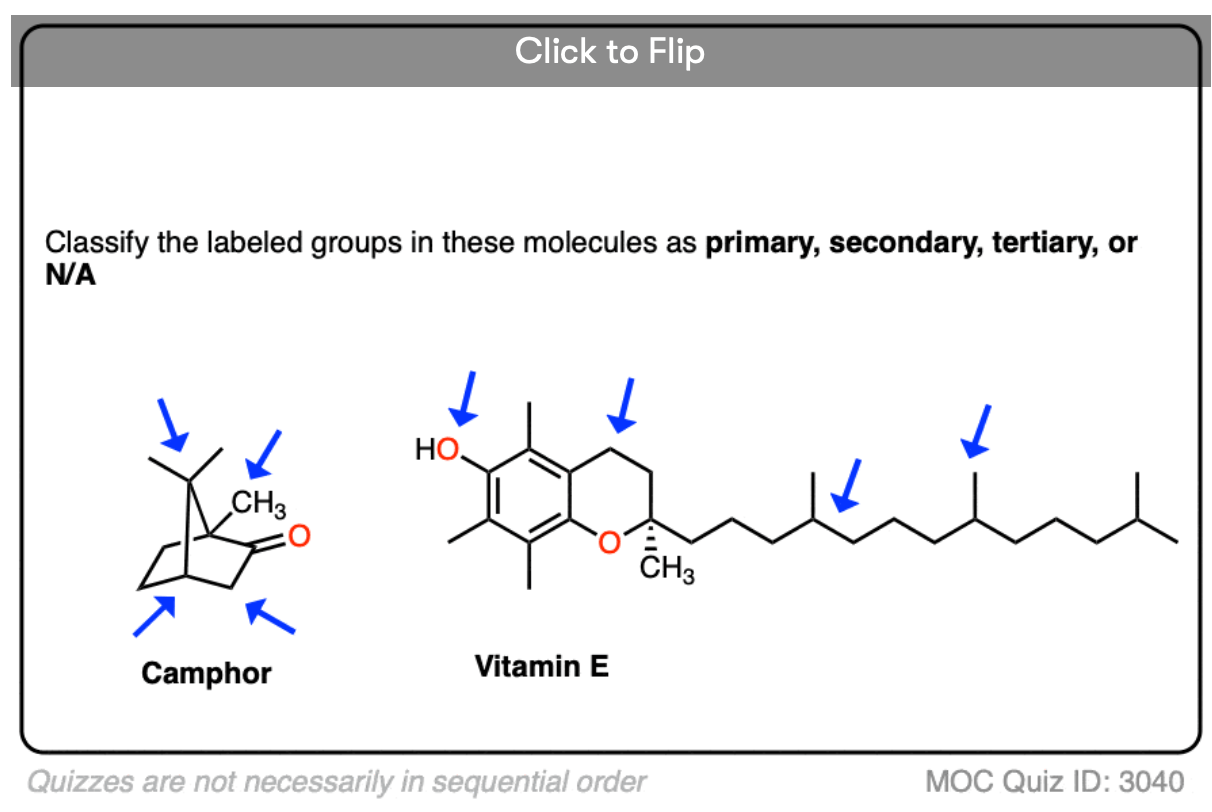
Become a MOC member to see the clickable quiz with answers on the back.
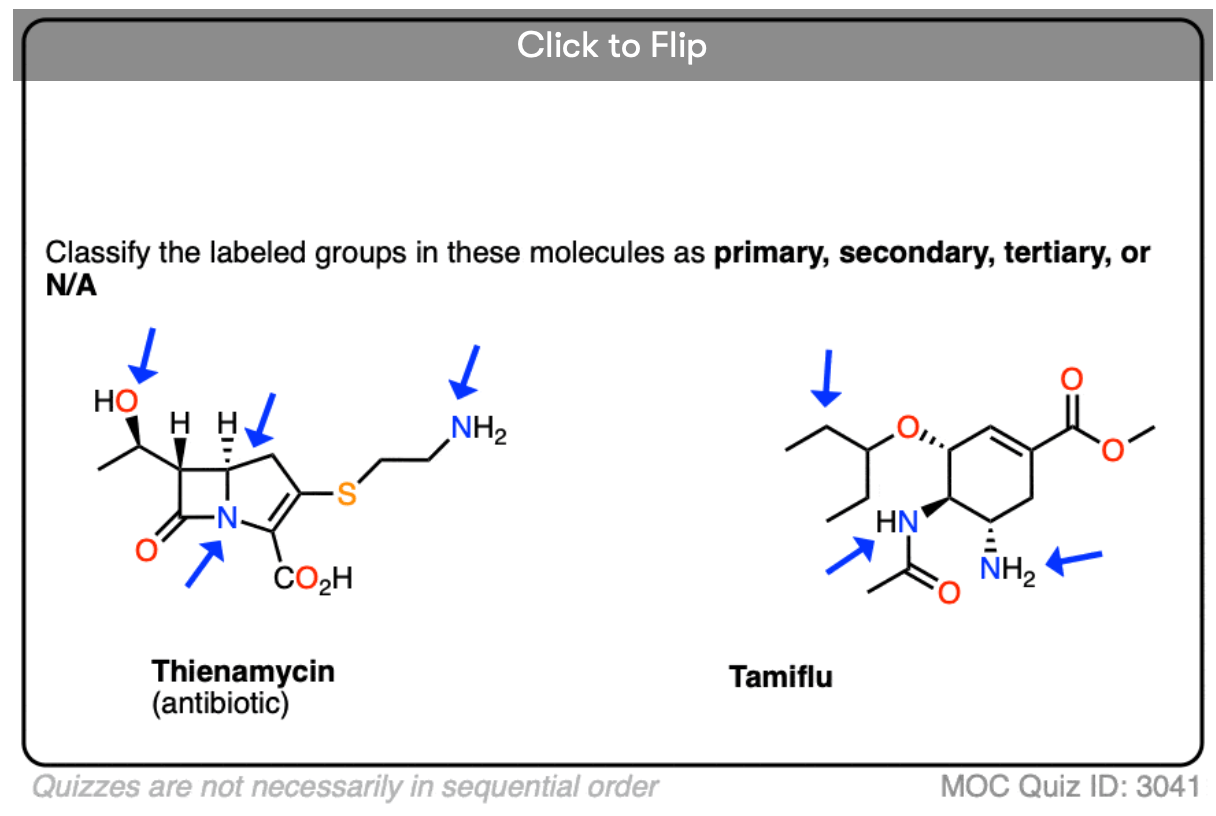
Become a MOC member to see the clickable quiz with answers on the back.

Become a MOC member to see the clickable quiz with answers on the back.
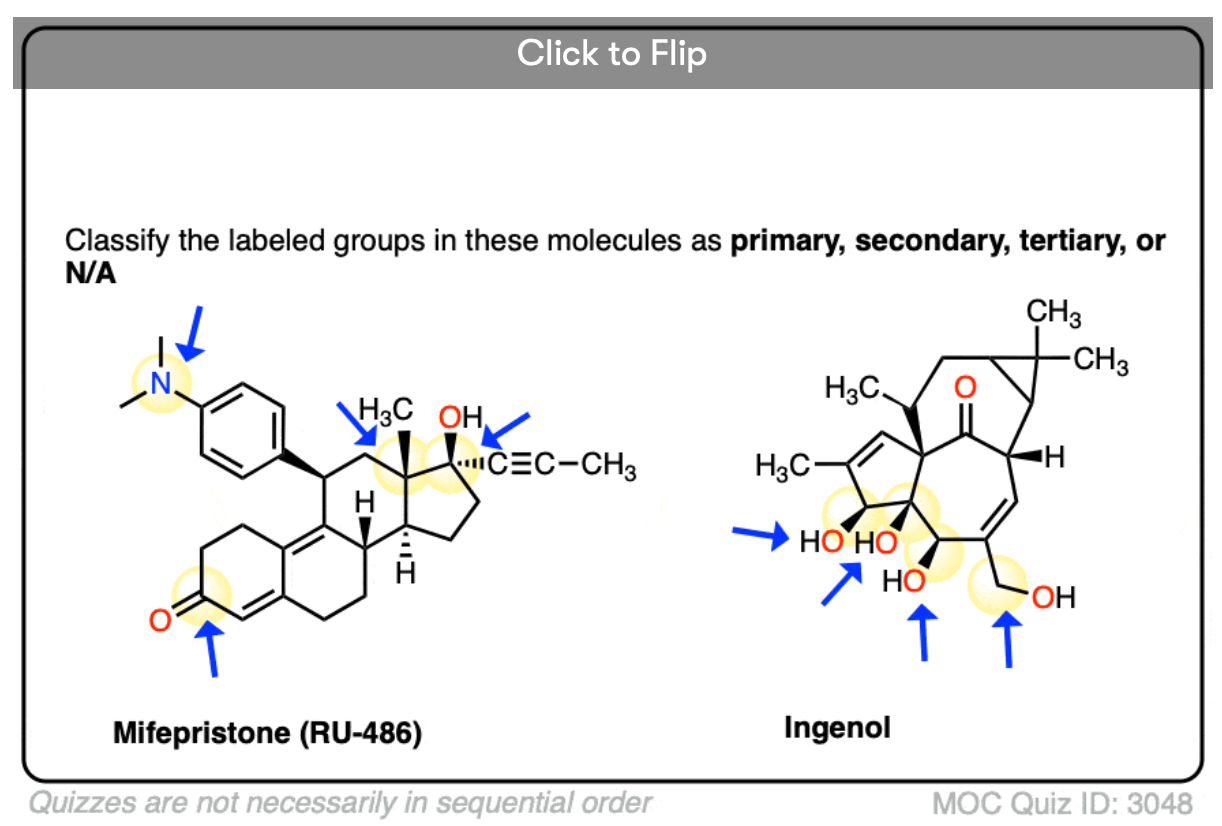
Become a MOC member to see the clickable quiz with answers on the back.
(Advanced) References and Further Reading
Some IUPAC definitions on nomenclature:
- Alcohols. From the IUPAC Gold Book.
DOI: 10.1351/goldbook.A00204 - Amines. From the IUPAC Gold Book.
DOI: 10.1351/goldbook.A00274 - Amides. From the IUPAC Gold Book.
DOI: 10.1351/goldbook.A00266
Note that IUPAC’s definition of primary, secondary, and tertiary amides is not the definition of primary, secondary, and tertiary amides that is in colloquial use.
00 General Chemistry Review
01 Bonding, Structure, and Resonance
- How Do We Know Methane (CH4) Is Tetrahedral?
- Hybrid Orbitals and Hybridization
- How To Determine Hybridization: A Shortcut
- Orbital Hybridization And Bond Strengths
- Sigma bonds come in six varieties: Pi bonds come in one
- A Key Skill: How to Calculate Formal Charge
- The Four Intermolecular Forces and How They Affect Boiling Points
- 3 Trends That Affect Boiling Points
- How To Use Electronegativity To Determine Electron Density (and why NOT to trust formal charge)
- Introduction to Resonance
- How To Use Curved Arrows To Interchange Resonance Forms
- Evaluating Resonance Forms (1) - The Rule of Least Charges
- How To Find The Best Resonance Structure By Applying Electronegativity
- Evaluating Resonance Structures With Negative Charges
- Evaluating Resonance Structures With Positive Charge
- Exploring Resonance: Pi-Donation
- Exploring Resonance: Pi-acceptors
- In Summary: Evaluating Resonance Structures
- Drawing Resonance Structures: 3 Common Mistakes To Avoid
- How to apply electronegativity and resonance to understand reactivity
- Bond Hybridization Practice
- Structure and Bonding Practice Quizzes
- Resonance Structures Practice
02 Acid Base Reactions
- Introduction to Acid-Base Reactions
- Acid Base Reactions In Organic Chemistry
- The Stronger The Acid, The Weaker The Conjugate Base
- Walkthrough of Acid-Base Reactions (3) - Acidity Trends
- Five Key Factors That Influence Acidity
- Acid-Base Reactions: Introducing Ka and pKa
- How to Use a pKa Table
- The pKa Table Is Your Friend
- A Handy Rule of Thumb for Acid-Base Reactions
- Acid Base Reactions Are Fast
- pKa Values Span 60 Orders Of Magnitude
- How Protonation and Deprotonation Affect Reactivity
- Acid Base Practice Problems
03 Alkanes and Nomenclature
- Meet the (Most Important) Functional Groups
- Condensed Formulas: Deciphering What the Brackets Mean
- Hidden Hydrogens, Hidden Lone Pairs, Hidden Counterions
- Don't Be Futyl, Learn The Butyls
- Primary, Secondary, Tertiary, Quaternary In Organic Chemistry
- Branching, and Its Affect On Melting and Boiling Points
- The Many, Many Ways of Drawing Butane
- Wedge And Dash Convention For Tetrahedral Carbon
- Common Mistakes in Organic Chemistry: Pentavalent Carbon
- Table of Functional Group Priorities for Nomenclature
- Summary Sheet - Alkane Nomenclature
- Organic Chemistry IUPAC Nomenclature Demystified With A Simple Puzzle Piece Approach
- Boiling Point Quizzes
- Organic Chemistry Nomenclature Quizzes
04 Conformations and Cycloalkanes
- Staggered vs Eclipsed Conformations of Ethane
- Conformational Isomers of Propane
- Newman Projection of Butane (and Gauche Conformation)
- Introduction to Cycloalkanes
- Geometric Isomers In Small Rings: Cis And Trans Cycloalkanes
- Calculation of Ring Strain In Cycloalkanes
- Cycloalkanes - Ring Strain In Cyclopropane And Cyclobutane
- Cyclohexane Conformations
- Cyclohexane Chair Conformation: An Aerial Tour
- How To Draw The Cyclohexane Chair Conformation
- The Cyclohexane Chair Flip
- The Cyclohexane Chair Flip - Energy Diagram
- Substituted Cyclohexanes - Axial vs Equatorial
- Ranking The Bulkiness Of Substituents On Cyclohexanes: "A-Values"
- Cyclohexane Chair Conformation Stability: Which One Is Lower Energy?
- Fused Rings - Cis-Decalin and Trans-Decalin
- Naming Bicyclic Compounds - Fused, Bridged, and Spiro
- Bredt's Rule (And Summary of Cycloalkanes)
- Newman Projection Practice
- Cycloalkanes Practice Problems
05 A Primer On Organic Reactions
- The Most Important Question To Ask When Learning a New Reaction
- Curved Arrows (for reactions)
- Nucleophiles and Electrophiles
- The Three Classes of Nucleophiles
- Nucleophilicity vs. Basicity
- What Makes A Good Nucleophile?
- What Makes A Good Leaving Group?
- 3 Factors That Stabilize Carbocations
- Equilibrium and Energy Relationships
- 7 Factors that stabilize negative charge in organic chemistry
- 7 Factors That Stabilize Positive Charge in Organic Chemistry
- What's a Transition State?
- Hammond's Postulate
- Learning Organic Chemistry Reactions: A Checklist (PDF)
- Introduction to Oxidative Cleavage Reactions
06 Free Radical Reactions
- Bond Dissociation Energies = Homolytic Cleavage
- Free Radical Reactions
- 3 Factors That Stabilize Free Radicals
- What Factors Destabilize Free Radicals?
- Bond Strengths And Radical Stability
- Free Radical Initiation: Why Is "Light" Or "Heat" Required?
- Initiation, Propagation, Termination
- Monochlorination Products Of Propane, Pentane, And Other Alkanes
- Selectivity In Free Radical Reactions
- Selectivity in Free Radical Reactions: Bromination vs. Chlorination
- Halogenation At Tiffany's
- Allylic Bromination
- Bonus Topic: Allylic Rearrangements
- In Summary: Free Radicals
- Synthesis (2) - Reactions of Alkanes
- Free Radicals Practice Quizzes
07 Stereochemistry and Chirality
- Types of Isomers: Constitutional Isomers, Stereoisomers, Enantiomers, and Diastereomers
- How To Draw The Enantiomer Of A Chiral Molecule
- How To Draw A Bond Rotation
- Introduction to Assigning (R) and (S): The Cahn-Ingold-Prelog Rules
- Assigning Cahn-Ingold-Prelog (CIP) Priorities (2) - The Method of Dots
- Enantiomers vs Diastereomers vs The Same? Two Methods For Solving Problems
- Assigning R/S To Newman Projections (And Converting Newman To Line Diagrams)
- How To Determine R and S Configurations On A Fischer Projection
- The Meso Trap
- Optical Rotation, Optical Activity, and Specific Rotation
- Optical Purity and Enantiomeric Excess
- What's a Racemic Mixture?
- Chiral Allenes And Chiral Axes
- Stereochemistry Practice Problems and Quizzes
08 Substitution Reactions
- Nucleophilic Substitution Reactions - Introduction
- Two Types of Nucleophilic Substitution Reactions
- The SN2 Mechanism
- Why the SN2 Reaction Is Powerful
- The SN1 Mechanism
- The Conjugate Acid Is A Better Leaving Group
- Comparing the SN1 and SN2 Reactions
- Polar Protic? Polar Aprotic? Nonpolar? All About Solvents
- Steric Hindrance is Like a Fat Goalie
- Common Blind Spot: Intramolecular Reactions
- Substitution Practice - SN1
- Substitution Practice - SN2
09 Elimination Reactions
- Elimination Reactions (1): Introduction And The Key Pattern
- Elimination Reactions (2): The Zaitsev Rule
- Elimination Reactions Are Favored By Heat
- Two Elimination Reaction Patterns
- The E1 Reaction
- The E2 Mechanism
- E1 vs E2: Comparing the E1 and E2 Reactions
- Antiperiplanar Relationships: The E2 Reaction and Cyclohexane Rings
- Bulky Bases in Elimination Reactions
- Comparing the E1 vs SN1 Reactions
- Elimination (E1) Reactions With Rearrangements
- E1cB - Elimination (Unimolecular) Conjugate Base
- Elimination (E1) Practice Problems And Solutions
- Elimination (E2) Practice Problems and Solutions
10 Rearrangements
11 SN1/SN2/E1/E2 Decision
- Identifying Where Substitution and Elimination Reactions Happen
- Deciding SN1/SN2/E1/E2 (1) - The Substrate
- Deciding SN1/SN2/E1/E2 (2) - The Nucleophile/Base
- SN1 vs E1 and SN2 vs E2 : The Temperature
- Deciding SN1/SN2/E1/E2 - The Solvent
- Wrapup: The Key Factors For Determining SN1/SN2/E1/E2
- Alkyl Halide Reaction Map And Summary
- SN1 SN2 E1 E2 Practice Problems
12 Alkene Reactions
- E and Z Notation For Alkenes (+ Cis/Trans)
- Alkene Stability
- Alkene Addition Reactions: "Regioselectivity" and "Stereoselectivity" (Syn/Anti)
- Stereoselective and Stereospecific Reactions
- Hydrohalogenation of Alkenes and Markovnikov's Rule
- Hydration of Alkenes With Aqueous Acid
- Rearrangements in Alkene Addition Reactions
- Halogenation of Alkenes and Halohydrin Formation
- Oxymercuration Demercuration of Alkenes
- Hydroboration Oxidation of Alkenes
- m-CPBA (meta-chloroperoxybenzoic acid)
- OsO4 (Osmium Tetroxide) for Dihydroxylation of Alkenes
- Palladium on Carbon (Pd/C) for Catalytic Hydrogenation of Alkenes
- Cyclopropanation of Alkenes
- A Fourth Alkene Addition Pattern - Free Radical Addition
- Alkene Reactions: Ozonolysis
- Summary: Three Key Families Of Alkene Reaction Mechanisms
- Synthesis (4) - Alkene Reaction Map, Including Alkyl Halide Reactions
- Alkene Reactions Practice Problems
13 Alkyne Reactions
- Acetylides from Alkynes, And Substitution Reactions of Acetylides
- Partial Reduction of Alkynes With Lindlar's Catalyst
- Partial Reduction of Alkynes With Na/NH3 To Obtain Trans Alkenes
- Alkyne Hydroboration With "R2BH"
- Hydration and Oxymercuration of Alkynes
- Hydrohalogenation of Alkynes
- Alkyne Halogenation: Bromination, Chlorination, and Iodination of Alkynes
- Alkyne Reactions - The "Concerted" Pathway
- Alkenes To Alkynes Via Halogenation And Elimination Reactions
- Alkynes Are A Blank Canvas
- Synthesis (5) - Reactions of Alkynes
- Alkyne Reactions Practice Problems With Answers
14 Alcohols, Epoxides and Ethers
- Alcohols - Nomenclature and Properties
- Alcohols Can Act As Acids Or Bases (And Why It Matters)
- Alcohols - Acidity and Basicity
- The Williamson Ether Synthesis
- Ethers From Alkenes, Tertiary Alkyl Halides and Alkoxymercuration
- Alcohols To Ethers via Acid Catalysis
- Cleavage Of Ethers With Acid
- Epoxides - The Outlier Of The Ether Family
- Opening of Epoxides With Acid
- Epoxide Ring Opening With Base
- Making Alkyl Halides From Alcohols
- Tosylates And Mesylates
- PBr3 and SOCl2
- Elimination Reactions of Alcohols
- Elimination of Alcohols To Alkenes With POCl3
- Alcohol Oxidation: "Strong" and "Weak" Oxidants
- Demystifying The Mechanisms of Alcohol Oxidations
- Protecting Groups For Alcohols
- Thiols And Thioethers
- Calculating the oxidation state of a carbon
- Oxidation and Reduction in Organic Chemistry
- Oxidation Ladders
- SOCl2 Mechanism For Alcohols To Alkyl Halides: SN2 versus SNi
- Alcohol Reactions Roadmap (PDF)
- Alcohol Reaction Practice Problems
- Epoxide Reaction Quizzes
- Oxidation and Reduction Practice Quizzes
15 Organometallics
- What's An Organometallic?
- Formation of Grignard and Organolithium Reagents
- Organometallics Are Strong Bases
- Reactions of Grignard Reagents
- Protecting Groups In Grignard Reactions
- Synthesis Problems Involving Grignard Reagents
- Grignard Reactions And Synthesis (2)
- Organocuprates (Gilman Reagents): How They're Made
- Gilman Reagents (Organocuprates): What They're Used For
- The Heck, Suzuki, and Olefin Metathesis Reactions (And Why They Don't Belong In Most Introductory Organic Chemistry Courses)
- Reaction Map: Reactions of Organometallics
- Grignard Practice Problems
16 Spectroscopy
- Degrees of Unsaturation (or IHD, Index of Hydrogen Deficiency)
- Conjugation And Color (+ How Bleach Works)
- Introduction To UV-Vis Spectroscopy
- UV-Vis Spectroscopy: Absorbance of Carbonyls
- UV-Vis Spectroscopy: Practice Questions
- Bond Vibrations, Infrared Spectroscopy, and the "Ball and Spring" Model
- Infrared Spectroscopy: A Quick Primer On Interpreting Spectra
- IR Spectroscopy: 4 Practice Problems
- 1H NMR: How Many Signals?
- Homotopic, Enantiotopic, Diastereotopic
- Diastereotopic Protons in 1H NMR Spectroscopy: Examples
- 13-C NMR - How Many Signals
- Liquid Gold: Pheromones In Doe Urine
- Natural Product Isolation (1) - Extraction
- Natural Product Isolation (2) - Purification Techniques, An Overview
- Structure Determination Case Study: Deer Tarsal Gland Pheromone
17 Dienes and MO Theory
- What To Expect In Organic Chemistry 2
- Are these molecules conjugated?
- Conjugation And Resonance In Organic Chemistry
- Bonding And Antibonding Pi Orbitals
- Molecular Orbitals of The Allyl Cation, Allyl Radical, and Allyl Anion
- Pi Molecular Orbitals of Butadiene
- Reactions of Dienes: 1,2 and 1,4 Addition
- Thermodynamic and Kinetic Products
- More On 1,2 and 1,4 Additions To Dienes
- s-cis and s-trans
- The Diels-Alder Reaction
- Cyclic Dienes and Dienophiles in the Diels-Alder Reaction
- Stereochemistry of the Diels-Alder Reaction
- Exo vs Endo Products In The Diels Alder: How To Tell Them Apart
- HOMO and LUMO In the Diels Alder Reaction
- Why Are Endo vs Exo Products Favored in the Diels-Alder Reaction?
- Diels-Alder Reaction: Kinetic and Thermodynamic Control
- The Retro Diels-Alder Reaction
- The Intramolecular Diels Alder Reaction
- Regiochemistry In The Diels-Alder Reaction
- The Cope and Claisen Rearrangements
- Electrocyclic Reactions
- Electrocyclic Ring Opening And Closure (2) - Six (or Eight) Pi Electrons
- Diels Alder Practice Problems
- Molecular Orbital Theory Practice
18 Aromaticity
- Introduction To Aromaticity
- Rules For Aromaticity
- Huckel's Rule: What Does 4n+2 Mean?
- Aromatic, Non-Aromatic, or Antiaromatic? Some Practice Problems
- Antiaromatic Compounds and Antiaromaticity
- The Pi Molecular Orbitals of Benzene
- The Pi Molecular Orbitals of Cyclobutadiene
- Frost Circles
- Aromaticity Practice Quizzes
19 Reactions of Aromatic Molecules
- Electrophilic Aromatic Substitution: Introduction
- Activating and Deactivating Groups In Electrophilic Aromatic Substitution
- Electrophilic Aromatic Substitution - The Mechanism
- Ortho-, Para- and Meta- Directors in Electrophilic Aromatic Substitution
- Understanding Ortho, Para, and Meta Directors
- Why are halogens ortho- para- directors?
- Disubstituted Benzenes: The Strongest Electron-Donor "Wins"
- Electrophilic Aromatic Substitutions (1) - Halogenation of Benzene
- Electrophilic Aromatic Substitutions (2) - Nitration and Sulfonation
- EAS Reactions (3) - Friedel-Crafts Acylation and Friedel-Crafts Alkylation
- Intramolecular Friedel-Crafts Reactions
- Nucleophilic Aromatic Substitution (NAS)
- Nucleophilic Aromatic Substitution (2) - The Benzyne Mechanism
- Reactions on the "Benzylic" Carbon: Bromination And Oxidation
- The Wolff-Kishner, Clemmensen, And Other Carbonyl Reductions
- More Reactions on the Aromatic Sidechain: Reduction of Nitro Groups and the Baeyer Villiger
- Aromatic Synthesis (1) - "Order Of Operations"
- Synthesis of Benzene Derivatives (2) - Polarity Reversal
- Aromatic Synthesis (3) - Sulfonyl Blocking Groups
- Birch Reduction
- Synthesis (7): Reaction Map of Benzene and Related Aromatic Compounds
- Aromatic Reactions and Synthesis Practice
- Electrophilic Aromatic Substitution Practice Problems
20 Aldehydes and Ketones
- What's The Alpha Carbon In Carbonyl Compounds?
- Nucleophilic Addition To Carbonyls
- Aldehydes and Ketones: 14 Reactions With The Same Mechanism
- Sodium Borohydride (NaBH4) Reduction of Aldehydes and Ketones
- Grignard Reagents For Addition To Aldehydes and Ketones
- Wittig Reaction
- Hydrates, Hemiacetals, and Acetals
- Imines - Properties, Formation, Reactions, and Mechanisms
- All About Enamines
- Breaking Down Carbonyl Reaction Mechanisms: Reactions of Anionic Nucleophiles (Part 2)
- Aldehydes Ketones Reaction Practice
21 Carboxylic Acid Derivatives
- Nucleophilic Acyl Substitution (With Negatively Charged Nucleophiles)
- Addition-Elimination Mechanisms With Neutral Nucleophiles (Including Acid Catalysis)
- Basic Hydrolysis of Esters - Saponification
- Transesterification
- Proton Transfer
- Fischer Esterification - Carboxylic Acid to Ester Under Acidic Conditions
- Lithium Aluminum Hydride (LiAlH4) For Reduction of Carboxylic Acid Derivatives
- LiAlH[Ot-Bu]3 For The Reduction of Acid Halides To Aldehydes
- Di-isobutyl Aluminum Hydride (DIBAL) For The Partial Reduction of Esters and Nitriles
- Amide Hydrolysis
- Thionyl Chloride (SOCl2) And Conversion of Carboxylic Acids to Acid Halides
- Diazomethane (CH2N2)
- Carbonyl Chemistry: Learn Six Mechanisms For the Price Of One
- Making Music With Mechanisms (PADPED)
- Carboxylic Acid Derivatives Practice Questions
22 Enols and Enolates
- Keto-Enol Tautomerism
- Enolates - Formation, Stability, and Simple Reactions
- Kinetic Versus Thermodynamic Enolates
- Aldol Addition and Condensation Reactions
- Reactions of Enols - Acid-Catalyzed Aldol, Halogenation, and Mannich Reactions
- Claisen Condensation and Dieckmann Condensation
- Decarboxylation
- The Malonic Ester and Acetoacetic Ester Synthesis
- The Michael Addition Reaction and Conjugate Addition
- The Robinson Annulation
- Haloform Reaction
- The Hell–Volhard–Zelinsky Reaction
- Enols and Enolates Practice Quizzes
23 Amines
- The Amide Functional Group: Properties, Synthesis, and Nomenclature
- Basicity of Amines And pKaH
- 5 Key Basicity Trends of Amines
- The Mesomeric Effect And Aromatic Amines
- Nucleophilicity of Amines
- Alkylation of Amines (Sucks!)
- Reductive Amination
- The Gabriel Synthesis
- Some Reactions of Azides
- The Hofmann Elimination
- The Hofmann and Curtius Rearrangements
- The Cope Elimination
- Protecting Groups for Amines - Carbamates
- The Strecker Synthesis of Amino Acids
- Introduction to Peptide Synthesis
- Reactions of Diazonium Salts: Sandmeyer and Related Reactions
- Amine Practice Questions
24 Carbohydrates
- D and L Notation For Sugars
- Pyranoses and Furanoses: Ring-Chain Tautomerism In Sugars
- What is Mutarotation?
- Reducing Sugars
- The Big Damn Post Of Carbohydrate-Related Chemistry Definitions
- The Haworth Projection
- Converting a Fischer Projection To A Haworth (And Vice Versa)
- Reactions of Sugars: Glycosylation and Protection
- The Ruff Degradation and Kiliani-Fischer Synthesis
- Isoelectric Points of Amino Acids (and How To Calculate Them)
- Carbohydrates Practice
- Amino Acid Quizzes
25 Fun and Miscellaneous
- A Gallery of Some Interesting Molecules From Nature
- Screw Organic Chemistry, I'm Just Going To Write About Cats
- On Cats, Part 1: Conformations and Configurations
- On Cats, Part 2: Cat Line Diagrams
- On Cats, Part 4: Enantiocats
- On Cats, Part 6: Stereocenters
- Organic Chemistry Is Shit
- The Organic Chemistry Behind "The Pill"
- Maybe they should call them, "Formal Wins" ?
- Why Do Organic Chemists Use Kilocalories?
- The Principle of Least Effort
- Organic Chemistry GIFS - Resonance Forms
- Reproducibility In Organic Chemistry
- What Holds The Nucleus Together?
- How Reactions Are Like Music
- Organic Chemistry and the New MCAT
26 Organic Chemistry Tips and Tricks
- Common Mistakes: Formal Charges Can Mislead
- Partial Charges Give Clues About Electron Flow
- Draw The Ugly Version First
- Organic Chemistry Study Tips: Learn the Trends
- The 8 Types of Arrows In Organic Chemistry, Explained
- Top 10 Skills To Master Before An Organic Chemistry 2 Final
- Common Mistakes with Carbonyls: Carboxylic Acids... Are Acids!
- Planning Organic Synthesis With "Reaction Maps"
- Alkene Addition Pattern #1: The "Carbocation Pathway"
- Alkene Addition Pattern #2: The "Three-Membered Ring" Pathway
- Alkene Addition Pattern #3: The "Concerted" Pathway
- Number Your Carbons!
- The 4 Major Classes of Reactions in Org 1
- How (and why) electrons flow
- Grossman's Rule
- Three Exam Tips
- A 3-Step Method For Thinking Through Synthesis Problems
- Putting It Together
- Putting Diels-Alder Products in Perspective
- The Ups and Downs of Cyclohexanes
- The Most Annoying Exceptions in Org 1 (Part 1)
- The Most Annoying Exceptions in Org 1 (Part 2)
- The Marriage May Be Bad, But the Divorce Still Costs Money
- 9 Nomenclature Conventions To Know
- Nucleophile attacks Electrophile
27 Case Studies of Successful O-Chem Students
- Success Stories: How Corina Got The The "Hard" Professor - And Got An A+ Anyway
- How Helena Aced Organic Chemistry
- From a "Drop" To B+ in Org 2 – How A Hard Working Student Turned It Around
- How Serge Aced Organic Chemistry
- Success Stories: How Zach Aced Organic Chemistry 1
- Success Stories: How Kari Went From C– to B+
- How Esther Bounced Back From a "C" To Get A's In Organic Chemistry 1 And 2
- How Tyrell Got The Highest Grade In Her Organic Chemistry Course
- This Is Why Students Use Flashcards
- Success Stories: How Stu Aced Organic Chemistry
- How John Pulled Up His Organic Chemistry Exam Grades
- Success Stories: How Nathan Aced Organic Chemistry (Without It Taking Over His Life)
- How Chris Aced Org 1 and Org 2
- Interview: How Jay Got an A+ In Organic Chemistry
- How to Do Well in Organic Chemistry: One Student's Advice
- "America's Top TA" Shares His Secrets For Teaching O-Chem
- "Organic Chemistry Is Like..." - A Few Metaphors
- How To Do Well In Organic Chemistry: Advice From A Tutor
- Guest post: "I went from being afraid of tests to actually looking forward to them".
I would not say that carbon is pentavalent in the molecular ion CH5+. There 1 carbon and 5 protons are bonded by 8 electrons, not 10. So, carbonis certainly pentacoordinated, but not hypervalent.
Is a tri-alkylated alpha to carbonyl is considered tertiary or quaternary?
For example, is Baeyer Villiger oxidation, is the rate of migration
H > 3 > 2 > 1 > Me
or
H > 4 > 3 > 2 > 1
It would be considered tertiary. So your first listing is correct.
For more, see Note #3 in this post:
https://www.masterorganicchemistry.com/2018/10/08/nitration-baeyer-villiger/#notes
why can tertiary amines cross the blood-brain barrier but not quaternary amines?
Cyclohexanol is a secondary alcohol. Is the hydroxyl carbon properly referred to as secondary (two carbons attached) or tertiary (one hydrogen attached)?
Secondary alcohol.
Thank you !!!
What type of carbon is methane?(in the case of primary, secondary, tertiary or quaternary)
Or it called something else??
Can you help me plz!
It is unique and belongs in its own category, like ammonia (NH3) for amines and methanol (CH3OH) for alcohols. The terms primary, secondary, tertiary do not apply.
What if double bond? Is it still consider to be a primary (If it only one carbon bonded)?
Hi Josh – no, primary, secondary, tertiary is not the appropriate nomenclature with double bonds. We’ll often classify them by treating the C-C double bond as a unit and then counting how many carbons are bound to it. We can then have monosubstituted, disubstituted, trisubstituted and tetrasubstituted double bonds. That’s not quite enough, because there are actually 3 ways to have disubstituted double bonds!
These we refer to roughly as “cis”, “trans’ and 1,1-disubstituted.
See this post. https://www.masterorganicchemistry.com/2020/04/30/alkene-stability/
This helped, thanks 🙏🤗
In the case of imidazole is it possible to talk about primary, secondary, tertiary carbons or those names are only used for alkyls?
Only for alkyls.
What is the importance of quarternary carbon when naming molecules?
how many 2-degree carbon atoms are there in acetone, i mean is carbon atom bonded to oxygen considered as 2- degree or not?
I have never seen primary, secondary, tertiary, and quaternary is defined for carbons other than alkyl. Reference:
https://www.degruyter.com/view/j/pac.1995.67.issue-8-9/pac199567081307/pac199567081307.xml
Why doesn’t quaternary radical exist?
Think about the maximum number of substituents that carbon can have.
To be honest, you are the hero of organic chemistry .. thanks a lot !!!!!!!!!!
OK thanks hajar
why does amines doesn’t have the nomenclature as al others ? i mean in all other the functional grp is attached to the carbon is counted and hence primary or secondary name is given but in amines its not that way why?
Amines follow their own rules, both in nomenclature and in the flask…
LIFE CHANGING INFORMATION
Thank you for making this WAAAAAY easier then my teacher did! I really appreciate it.
OK – thanks for stopping by Mar, glad you find it useful!
what product would you expect from mono-bromination of p-methylbenzoic acid? somebody chew it up please
Go to this post. “Strongest donor wins”. https://www.masterorganicchemistry.com/2018/03/19/eas-disubstituted-benzenes/
So, Hello and can you describe the same things for hydrogen. Like 1° 2° 3°
Hydrogen. If Yes plz let me know.Thanx.
Was searching answer for my chemistry homework…..didnt got on book….remebered google has answer to each question….came here….understood everything in matter of seconds…blessed you with all my heart a good life…….THANK YOU James…??????
Why is the quaternary carbon the least reactive?
The least reactive in what sense?
How is the degree changed if there is a double bond involved?
Primary, secondary, tertiary is only defined for alkyl groups.
Why quarternary hydrogen doesnt exist ?
That’s an exercise for you to ponder.
Hello James,
Is there a technical term to call a carbon with one hydroxyl group attached? Can we call them “hydroxyl carbon” or “hydroxylic carbon”?
Thanks,
OJ
“Carbinol” is the preferred nomenclature
Can secondary carbon be attached to two carbons with one single bond, and one double bond?
Here is the problem which is on:
http://ir.kmu.edu.tw/bitstream/310902000/36554/2/%E9%86%AB%E8%97%A5%E6%9A%A8%E6%87%89%E7%94%A8%E5%8C%96%E5%AD%B8%E7%B3%BB%E7%A2%A9%E5%A3%AB%E7%8F%AD%E8%80%83%E5%8F%A4.pdf
The structure below is a potent analgesic agent (pain reliever) (J. Med. Chem., 2009, 5685). How many secondary carbons are in this structure?
I believe the definitions, “primary, secondary, tertiary” only hold for alkyl groups.
http://goldbook.iupac.org/A00228.html
So there would only be 6 secondary carbons and the alkenes do not count.
Hi there, may i know if we can describe the carbons in an aromatic compound as primary, secondary, tertiary or quaternary carbon? Or they are only applied to aliphatic carbons? Hope you can help. Thank you so much!
For alkenes, the convention is to use “monosubstituted”, “disubstituted”, etc. Same for arenes.
Finally! Someone was able to explain the primary, secondary, and tertiary amine thing. I’m not an O-chem guy at all, but I totally got this page. Thanks for putting it together. It finally makes sense.
D
Accutally you CAN put 5 substituents at one carbon – and the guy how can do this is called George Olah!
http://www.nobelprize.org/nobel_prizes/chemistry/laureates/1994/
SCNR Chris
Yes of course, pentavalent carbon cations (carboniums) are believed to exist, but James’ blog is intended for undergaduate-level students and he is quite right in presenting it as a non-option. This small white lie will save many students from mistakes, and those few that are interested in a more advanced truth can easily look into the matter themselves.
https://en.wikipedia.org/wiki/Carbonium_ion
https://en.wikipedia.org/wiki/Lie-to-children
How a carbon get a 10 electrons
Thank you for your site! It’s saving my Hiney!!
Hi James,
Just quickly looked at your website here. It looks good. I like to see other organic chemists getting busy with blogs, exploiting Web 2.0. I started off with a blog and decided I would build myself a website. It is my overglorified CV but I often post articles from industry. Check it out at pharmnbiofuel.com.
Brian